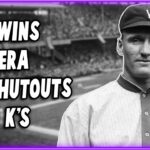How much is Sandy Koufax worth?
| Net Worth: | $12 Million |
|---|---|
| Profession: | Professional Baseball Pitcher |
| Date of Birth: | December 30, 1935 |
| Country: | United States of America |
| Height: | 1.88 m |
About Sandy Koufax
Koufax, who went to Lafayette High School in Brooklyn, was more well-known for his basketball prowess. He scored 16.5 points per game and served as captain his senior year. He was a left-handed catcher in his youth but switched to first base in high school. He didn’t begin pitching for a team in the Coney Island League until he was 17 years old.
Koufax enrolled at the rgw University of Cincinnati and, unbeknownst to the team’s head coach Ed Jucker, walked on as a freshman. He joined the varsity baseball team that spring and went 3-1 with 51 strikeouts in 31 innings pitched.
He participated in numerous Major League teams’ tryouts (New York Giants, Pittsburgh Pirates and the Brooklyn Dodgers). Koufax reputedly had the “greatest arm [he had] ever seen.” according to Branch Rickey, the Pirates’ general manager at the time. However, the Pirates took a while to provide him a contract, and by that time Koufax had opted to sign with the Dodgers for a $6,000 salary and $14,000 signing bonus, a “bonus baby” since his signing bonus was greater than his starting pay when he joined the Dodgers in 1954.
- Born: Dec. 30, 1935
- Hometown: Brooklyn, N.Y.
- Height:6-2
- Weight: 210 pounds
- Bats: Right
- Throws: Left
- Family: Married Anne Widmark (daughter of movie star Richard Widmark) in 1969 but was divorced in the 1980s. Later remarried and divorced again in the 1990s.
- Primary position: Starting pitcher
Profession Highlights
He was one of the best left-handed pitchers of all time, and over the final six of his 12 seasons with the Brooklyn/Los Angeles Dodgers, he had arguably the best pitching streak of all time. His left elbow arthritis forced him to leave his profession at the height of it when he was 30 years old, in 1966.
His final six years were by far his greatest; he received unanimous votes for the Cy Young Awards in 1963, 1965, and 1966. At a time when the Cy Young Award was given to the best pitcher across all of baseball, not just in particular leagues, he was the only pitcher to receive it three times. He came in third place in the 1964 Cy Young voting, narrowly missing out on a fourth such honor.
In 1963, he was elected the National League’s Most Valuable Player, and in 1965 and 1966, he came in second place in the voting for the award.
For six straight seasons, Koufax was picked to pitch in the All-Star Game (1961-66).
Koufax led all pitchers in both leagues in wins, strikeouts, and earned run average in each of his three Cy Young-winning seasons. He also had 269 strikeouts in 1961, which was the most in the majors.
His four no-hitters, one of which was the eighth perfect game in history, made him the first pitcher in major league history to accomplish this feat.
In his career, he struck out 2,396 batters, which ranked seventh among all pitchers at the time and was second only to Warren Spahn (2,583) among left-handers.
In his first six years with the Dodgers, he struggled, never winning more than 11 games in a single season. He won 129 games (21.2 per season) in his last six seasons, including three seasons with at least 25 victories.
In each of his final five seasons, Koufax posted the National League’s lowest earned run average.
His overall record was 165-87, which included a 36-40 mark in his first six seasons.
When Koufax struck out 18 batters in a game against the Giants on August 31, 1959, he tied the MLB record for strikeouts in a game at the time.
Because he wasn’t getting enough innings, Koufax asked Dodgers General Manager Buzzie Bavasi for a trade in the early 1960s. He was 8-13 at the end of that season when he thought about quitting the sport and starting a company selling gadgets.
He made the decision to attempt baseball once more. He entered the game in the best shape of his career, fixed a windup issue, and went on to strike out a league-high 269 hitters, shattering Christy Mathewson’s 58-year record (267). He finished the season with an 18-13 record and qualified for both All-Star Games (MLB back then had two All-Star Games).
Major League Baseball widened the striking zone in 1963. As a result, Koufax was able to lower the number of walks he gave up per nine innings from 3.4 in 1961 to 1.7. He won the first of his three Cy Young Awards while leading the league in wins (25), strikeouts (325), and ERA (1.88) while guiding the Dodgers to the pennant.
The 1963 season was Koufax’s most productive in terms of shutouts, with a league-high 11 recorded by the end of the year. In Games 1 and 4, Koufax defeated Whitey Ford of the Yankees to win the World Series MVP Award and assist the Dodgers in sweeping New York.
He had a 19-5 record in 1964, but arthritis caused his season to end in the middle of August.
He had additional arm issues in 1965, while leading the league in wins (26), strikeouts (382) and ERA (2.04). By declining to pitch in the opening game because of his adherence of Yom Kippur, he gained notoriety while helping the Dodgers advance to the World Series. His second World Series MVP award and another pennant for the Dodgers came after he lost Game 2 but rebounded with complete game shutouts in Games 5 and 7.
Before the 1966 campaign began, Koufax and teammate Don Drysdale rejected Bavasi’s proposals for new contracts and refused to sign until the final week of spring training. Despite pitching 323 innings and having a sore arm, Koufax recorded career highs of 27 wins (9 losses) and a 1.73 ERA. Though Hall of Famer Steve Carlton matched the 27 wins in 1972, no left-handed pitcher has since achieved more victories or a lower ERA in a season.
Following retirement
The year following his retirement, Koufax inked a $1 million, ten-year deal with NBC to host the network’s Saturday Game of the Week. Before the 1973 season began, he left after six years.
Just a few weeks after turning 36, Koufax was admitted to the Hall of Fame five years after his retirement in 1966. Compared to the previous youngest player, he was five months younger (Lou Gehrig in 1939). Koufax was the sixth player to have the distinction of being accepted on the first year that he was eligible.
The same year, Koufax’s number 32 was retired, joining the likes of Roy Campanella (39) and Jackie Robinson, two other legendary Dodgers (42).
In 1979, he agreed to become a minor league pitching coach with the Dodgers. Due to rumors of a tense relationship with Dodgers manager Tommy Lasorda, he quit in 1990.
Currently, Koufax is a member of the Baseball Assistance Team’s advisory board. This nonprofit group provides financial and medical support to players in the main league, minor league, and Negro League.
At the inaugural White House reception for Jewish American Heritage Month on May 27, 2010, Koufax was one of a number of notable Jewish Americans in attendance.



